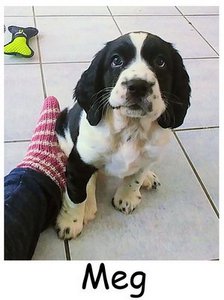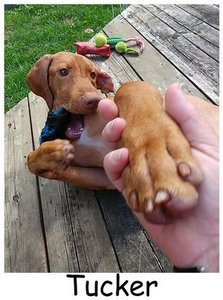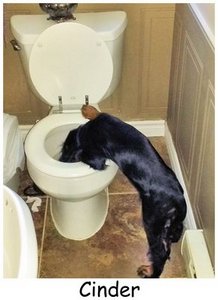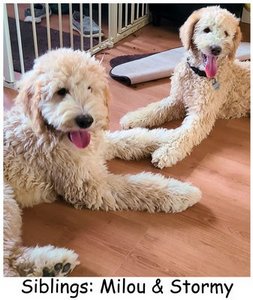 ~ ~  ~ ~  ~ ~  ~ ~ 
  Experts have long realized that dogs do NOT want to please US. They want to do whatever gives them a reward, be it treats, play, pat on the head, toy, and other things that make THEM happy.
Thus, in training a dog it's all about the REWARD . Experts have long realized that dogs do NOT want to please US. They want to do whatever gives them a reward, be it treats, play, pat on the head, toy, and other things that make THEM happy.
Thus, in training a dog it's all about the REWARD .
There are some things to remember when training your dog (and training yourself) ...
Puppy’s name should always be a happy thing. When you want your puppy to come to you make sure you are always happy and excited. A puppy may not come if he feels you are mad at him and is scared. He should always want to run to you.
A trick I learned when teaching “come”. Always hold his collar/harness once he gets to you. If the only time you reach for his neck is when he has to leave the park (for example) he will more than likely run away to play longer with his friends.
  Make sure you are CONFIDENT and CALM when training. Dogs are very sensitive to our slightest emotions. If you are nervous or unsure, he will be too. Leave the room for a moment to breath and reset when you are feeling unsettled. Make sure you are CONFIDENT and CALM when training. Dogs are very sensitive to our slightest emotions. If you are nervous or unsure, he will be too. Leave the room for a moment to breath and reset when you are feeling unsettled.
Watch his body language and sounds closely to identify when he has to go pee, he’s scared, bored, too tired, distracted, playful, hurt, etc. This will enable you to train him better and know his needs and emotional states.
To avoid confusion BE CONSISTENT... I can’t emphasize this enough. Don’t waiver from your training. Everyone in the house must be on the same page with puppy house rules and commands ( including guests).
 In the beginning keep the training sessions short. Depending on the age and attention span of your dog – 5 to 15 minutes each session at least 3 times a day. In the beginning keep the training sessions short. Depending on the age and attention span of your dog – 5 to 15 minutes each session at least 3 times a day.
 If the dog starts to lose interest, give him a command that he knows and end on a successful note. If the dog starts to lose interest, give him a command that he knows and end on a successful note.
Train in BABY STEPS. When he obeys 90% of the time you can then move forward with progress.
It’s normal to have to start over from square one from time to time or even just go back a step in training if training gets difficult.
Try to not let your dog get away too much with not obeying a command once they know it. The more you let him get away with ignoring you, the more he will keep ignoring you. Give him a few seconds to try to understand what you want and to obey. Lack of obedience may be a signal that you have to go back a step or two in training to reinforce the command.

 Do not repeat the command word over and over in succession. Say it once and wait. Give him time to think of what you want to begin to put together the command and the action. If the puppy is struggling then you may have to go back a step or two in training to reinforce the command. Do not repeat the command word over and over in succession. Say it once and wait. Give him time to think of what you want to begin to put together the command and the action. If the puppy is struggling then you may have to go back a step or two in training to reinforce the command.
Do not physically put his body into position when training. Calmly use your feet, legs, and hands with a treat to encourage the dog into position… walk into or block him. He needs to think it thru and do the action himself.
ABOVE ALL ELSE – KEEP TRAINING FUN LIKE A GAME!
 ~ ~  ~ ~  ~ ~   ~ ~  ~ ~ ~ ~ 
|




